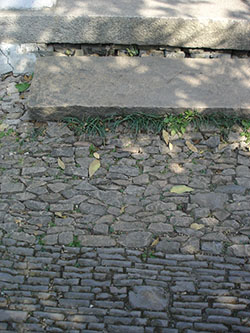| The temperature and shape of the ground imposes itself through the thin soles of cloth shoes. Through lightly clad feet we experience the specificity of time and locale. This is an existential circumstance, and a culturally determined one in constructed spaces. Literati shaped paths for mind-body journeys; and as part of this they paid attention to the design of the ground's surface. Variations were likened to the irregularity of Nature and served to return the stroller's attention to his corporality and relation to the Earth. Typical examples include surfaces where rough stones give way to bricks, or large smooth slabs are succeeded by patterned groups of pebbles that acted as so many points on the sole. The pleasure of such design is multi-faceted – not only the particular resistance each surface provides, but the differing glisten in sun and rain, and the chance discovery of old or uncommon materials. Ensembles can range from the rustic to the exquisitely detailed. The patterns of Suzhou garden homes often mixed materials to suggest casual, natural elegance as well as erudition. By contrast – and even in its un-restored and deteriorated condition – a Qing pavement from the Beijing palace (lower left) presents greater formality even as it makes use of simple materials. A work of considerable concentration, pebbles have been arranged with precise care, attending to colour, shape and pairing. In sentiment, it echoes fine textile work or court painting. | | 
 | 
 |